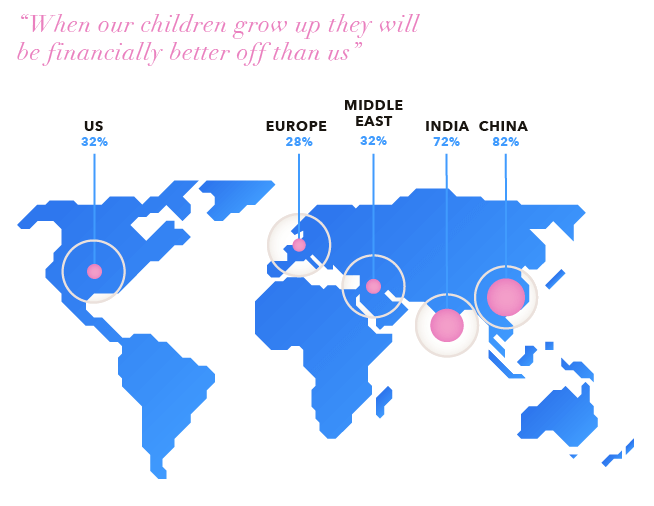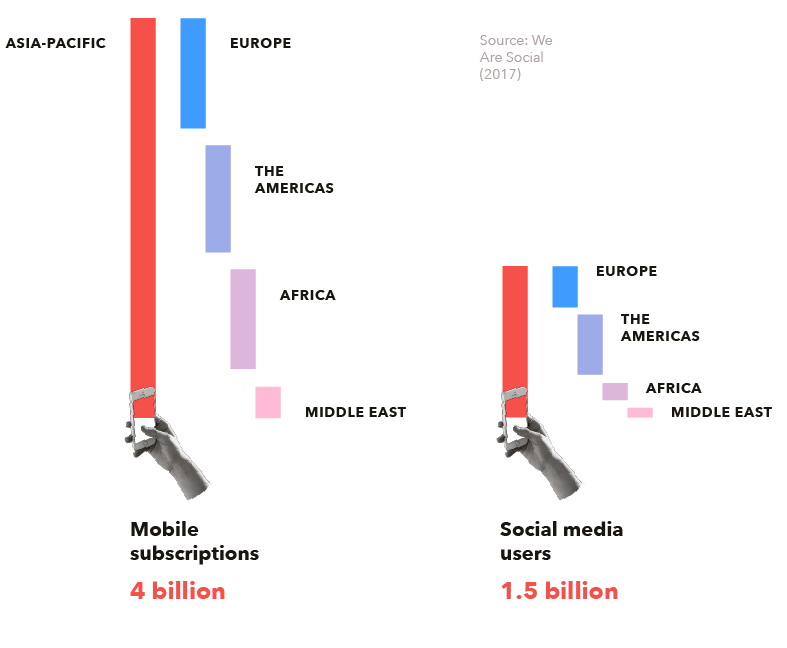Despite its bright future, Asia’s present took a new, darker turn in 2016. Yet amid the turmoil, two deep truths – aspiration and empowerment – should remain at the forefront of anyone looking to better serve or delight consumers.
Yes, 2016 contained some earthquakes. No, they didn’t all happen in the US and Europe – as if you needed reminding. But before we drive-by the events of 2016, let’s look forward. When it comes to populism, polarization and post-truth, what are the deep forces at work in Asia? And what do they mean for the future of consumerism?
The populist turn in Europe and North America is being fueled by waning relative economic power, and a related stagnation in middle-class living standards.
But Asia is moving in the opposite direction.
China and India – to take two (monumentally important!) examples – have seen staggering rises in both the size and living standards of their middle classes across the last decade. Since 2015, the Chinese middle class has been the largest in the world, numbering 109 million people against 92 million in the US, according to Credit Suisse. The billionaire capital of the world just shifted from NYC to Beijing, FFS!
Chinese and Indians are more positive about globalization than their US and European counterparts, and it’s no surprise that Chinese and Indian consumers are the most optimistic in the world when it comes to what the future holds:

So it’s all sunshine and optimism, then? Not quite…
Populism and Post-truth, Asia-style
Yes, it’s happening here too. Just in case you didn’t notice ;)
Populist politics is in the ascendant: May saw the election of the hardline populist Rodrigo Duterte in the Philippines, promising a violent crackdown on drugs. As part of his ongoing consolidation of power, October saw the Chinese community party declare president Xi Jinping ‘core leader’, a title closely associated with strongman Mao Zedong. November saw the impeachment of South Korean president Park Geun Hye after a popular outpouring of anger that saw street protests number 1 million people. The impeachment was upheld in March 2017. While Narendra Modi, India’s populist Prime Minister just had some stellar election results, too ;)
In the business arena meanwhile, there are signs of protectionist sentiment and retreat from the global innovation race. In India, a ‘startup war’ is being waged as local players Ola and Flipkart demand the government take protectionist measures against foreign rivals such as Amazon and Uber. That comes after 2016 saw GO-JEK in Indonesia run a ‘back to red and white’ campaign calling for UberMOTO and GrabBike drivers to switch allegiances in the name of national loyalty. And after a 60% increase in consumer complaints against short-term rentals, February 2017 saw Singapore make Airbnb and other similar platforms illegal. When business-friendly Singapore is turning protectionist, you know the mood is shifting!
In short: populism, polarization and the post-truth moment are powerful forces across the region, too. But their expression is context-specific.
Subscribe
Never miss a TrendWatching Quarterly Briefing!
Three Deep Drivers
First, a fast-growing middle class feels insecure, and that’s fueling new forms of populism. Yes, in recent years Asia has achieved economic growth, launched and adopted world-class innovations, and seen the rise of the largest middle classes in history.
Millions of this newly-emerged middle classes feel chronically insecure, and are concerned about falling backwards in the face of competition, stagnation and automation.
Take the most arresting story of populism in the region in 2016: in the Philippines, Dutertismo has been fueled by middle-class worries about crime and a helpless justice system, unreliable infrastructure, and elite corruption. Meanwhile, some 60% of middle-class Koreans still feel ‘poor’ (NH Investment and Securities, November 2016). There’s a similar story of middle-class insecurity taking place in China, India and beyond.
Second, the insane connectivity explosion is empowering people on a mass and unprecedented scale. Yes, you know the numbers, but it never hurts to remind yourself of just what a phenomenon the Asian mobile market is – close to 4 billon mobile subscriptions in Asia Pacific, more than the rest of the world combined.

The result? Billions of connected people have a voice and a platform to express their concerns, and, more importantly, the means to create their own solutions.
The manifestation varies across the region – from mobile-powered P2P solutions in China, to online humor platforms in India, to crowd-powered information systems in Southeast Asia. And if nothing else, the political exposé and ensuing presidential scandal engulfing Park Geun Hye in South Korea has shown that the power of a connected crowd is not to be underestimated.
Third, the whole world now wants in on Asian markets, and that’s driving protectionist sentiments. Of course global players want in on Asia’s next billion consumers. Saks Fifth Avenue is opening stores in India, Amazon is planning to launch in Southeast Asia, Macy’s is hosting live-streaming events for Chinese consumers.
This means the days when local businesses can thrive on a copy-paste strategy are long gone. Copying a successful global business and pasting a subpar version onto the Asian market won’t work. Today, Asian success stories need to be world-beaters!
That’s driving some to seek to shelter themselves from global competition by shutting out the world. Right now that might be being driven by Asian brands – think Ola and Flipkart asking the Indian government for protection. But how long until Asian middle-class workers start to fear that foreign businesses moving into Asia will mean fewer jobs for them?
Time For The Truth…
Okay, so how should YOU respond to thrive in this environment? Our global Trend Briefing discusses five truths to center your innovation around. Here we zoom in on the two most relevant to Asia: aspiration and empowerment. Each contains the key insights you need to understand how it is playing out in the region.
Understand the deep drivers, get inspired by the best-in-class brands that are responding to these currents, and get innovating. Ready, set, go!
Aspiration. Empowerment. Aren’t they old news?
Think some of these truths are so 2010? Think again. The underlying drivers and consumer needs served here might be age-old – transparency, empowerment, aspiration. But take a look at all the brands, businesses and startups we have featured, and you will see there are countless new, exciting ways to create innovations around these themes. And the most important consequence? Your consumers’ expectations around how your brand should serve them in better, more efficient, more meaningful ways are accelerating!
Yes, some will think these ideas don’t really matter to Asian consumers. “There’s no need for all this talk of empowerment – just give consumers a good product at a good price and they will be happy.” Maybe, for now. But trends travel and expectations transfer. When consumers see beauty brands developing products based on crowd-sourced consumer input, they will start wondering why your brand doesn’t listen to them the same way or create products tailored closer to their needs.
The lesson here? It doesn’t matter if you sell potato chips and laundry detergents, or insurance products, or even construction materials, your customer’s expectations around what brands and businesses should stand for will change, if not already. Don’t get left behind when the tide finally turns. Start today to build a future where brands are a force for good – meeting needs and exceeding expectations, creating value, and ultimately realizing better lives for billions in Asian consumer societies.
Let that thought sink in for a second, and GET INNOVATING. Good luck!
Subscribe
Never miss a TrendWatching Quarterly Briefing!
About The Author:
Reinier
IT TAKES A TEAM:
In the spirit of Asian community living – gotong royong, kampong style, 團結力量大, anekta mein ekta – this piece was put together with contributions from tw:in, TrendWatching Insight Network. Thank you to the spotters who shared their precious time and insights: Andrew Ong, Archana Iyer, Chirag Galundia, Diane Shen, Nicole Tan, Pooja Solanki, and Susan Mathen.
Related
Truthful Consumerism
The future of consumerism and brand strategy in a world of populism, polarization and post-truth!
Regional take
Truthful Consumerism in Latin America
Transparency and empowerment: two big, human truths for Latin innovators to run with in the post-truth era.
Regional take
Truthful Consumerism in Africa
Empowerment and tolerance: two truths for African brands to run with.
NEXT
The Bigger Picture
Learn more about our Trend-Driven Innovation methodology & how the five truths fit in.







